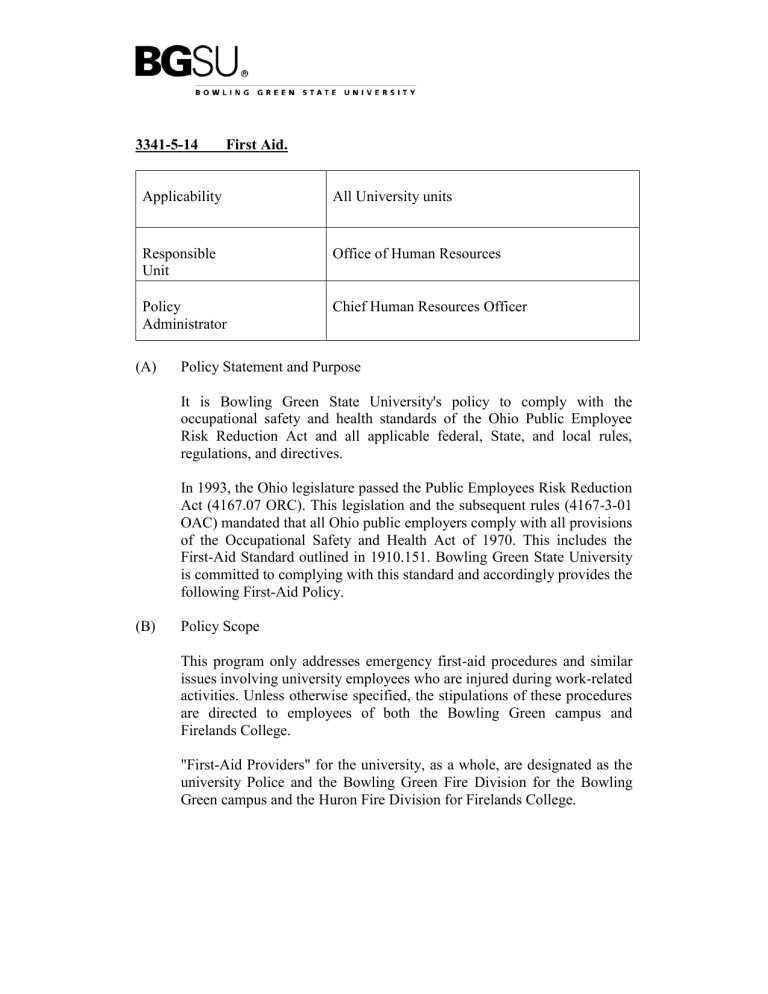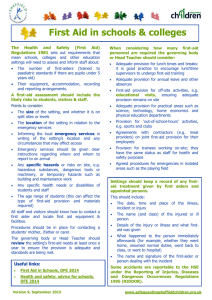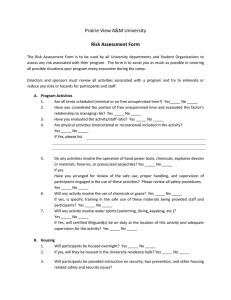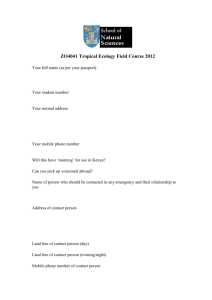3341-5-14 First Aid. Applicability All University units Responsible

3341-5-14 First Aid.
Applicability All University units
Responsible
Unit
Policy
Administrator
Office of Human Resources
Chief Human Resources Officer
(A) Policy Statement and Purpose
It is Bowling Green State University's policy to comply with the occupational safety and health standards of the Ohio Public Employee
Risk Reduction Act and all applicable federal, State, and local rules, regulations, and directives.
In 1993, the Ohio legislature passed the Public Employees Risk Reduction
Act (4167.07 ORC). This legislation and the subsequent rules (4167-3-01
OAC) mandated that all Ohio public employers comply with all provisions of the Occupational Safety and Health Act of 1970. This includes the
First-Aid Standard outlined in 1910.151. Bowling Green State University is committed to complying with this standard and accordingly provides the following First-Aid Policy.
(B) Policy Scope
This program only addresses emergency first-aid procedures and similar issues involving university employees who are injured during work-related activities. Unless otherwise specified, the stipulations of these procedures are directed to employees of both the Bowling Green campus and
Firelands College.
"First-Aid Providers" for the university, as a whole, are designated as the university Police and the Bowling Green Fire Division for the Bowling
Green campus and the Huron Fire Division for Firelands College.
3341-5-14
(C) Policy
(1) Injured Employees (Bowling Green Campus)
If a university employee is injured to the extent that a designated first-aid provider is needed, the university Police should be notified by calling "911" (on campus) or 372-2346 (off campus). If the caller requests an ambulance, the university Police Dispatcher will contact the Bowling Green Fire Division to dispatch an ambulance.
The Dispatcher will also send a university Police Officer to the scene. If the caller requests that only an officer be sent to the scene, the officer will initiate any first-aid treatment necessary to remedy the situation. Should the required treatment be beyond the scope of the officers' capabilities, the officer will direct the university Police Dispatcher to contact the Bowling Green Fire
Division requesting an ambulance.
Designated first-aid provides will determine the necessity to transport the injured employee(s) to the Wood County Hospital or other medical facility. All transportation of seriously injured employees to the Wood County Hospital will be provided by the
Bowling Green Fire Division.
(2) Injured Employees (Firelands College)
All reports of injuries to employees that require a designated firstaid provider should be made to the Huron City Fire Division by calling "911." If necessary, the Emergency Medical Service will transport the injured employee(s) to a local hospital.
(3) Other First Aid Considerations
(a) Injury Reporting - All injuries, regardless of severity, are to be reported to Environmental Health and Safety within 24 hours of the incident or as soon as possible using the
"BGSU Injury/Illness Report Form." If these forms are not currently available in your department/area office, call 2-
2171 (Bowling Green campus) or 2-0685 (Firelands campus).
2
3341-5-14
(b) Bloodborne Pathogens - All First-Aid Providers designated by the university are required to have pre-exposure
Hepatitis B vaccinations offered to them free of charge. All employees exposed to blood and/or other body fluids while performing first-aid or other work-related activities shall report this exposure to Environmental Health and Safety within 24 hours or as soon as possible using the "BGSU
Injury/Illness Report Form." The provisions of the university's Bloodborne Pathogen Exposure Control Plan shall be followed.
(c) Automated External Defibrillator (AED) - The use of an
AED must be reported to Environmental Health and Safety within twenty-four hours of the incident using the "Post-
Incident Report Form for Cardiac Arrests" found in
BGSU's written AED policy.
(3) First-Aid Kits
Designated first-aid providers are required to have first-aid supplies available. University Police vehicles contain first-aid supplies for use by designated responders.
Other university departments/areas that wish to have first-aid kits on-site, are encouraged to keep them maintained and to be knowledgeable of their use. First aid kits must be evaluated, at least, on an annual basis to ensure the first aid kit is stocked and does not contain any expired products. Each department needs to assign individual(s) responsible for evaluating their respective first aid kits. The American National Standards Institute/International
Safety Equipment Association standard, ANSI/ISEA Z308.1-2009, recommends the following contents as a minimum:
Item and Minimum Size or Volume Minimum Quantity
Absorbent Compress, 32 sq. in. (206 sq. cm), with no side smaller than 4 in. 1
(10cm)
Adhesive Bandages, 1 x 3 in. (2.5 x 7.5
16 cm)
Adhesive Tape, 3/8 in. x 2.5 yd. (2.3 m)
1 total
3
3341-5-14
Antiseptic, 0.14 fl. Oz. (0.5 g) application 10
Antibiotic Treatment, 0.14 oz. (0.5 g) 6
Burn Treatment, 1/32 oz. (0.9 g)
6 application
Medical Exam Gloves 2 pair
Sterile pad, 3 x 3 in. (7.5 x 7.5 cm) 4
Triangular Bandage, 40 x 40 x 56 in.
1
(101 x 101 x 142 cm)
First Aid Guide 1
In addition to the listed requirements, optional products and sizes should be included to augment the kit based upon the specific hazards existing in a particular work environment. Additional contents may include analgesics (pain relievers), bandage compress, breathing barrier, burn dressing cold pack, eye covering, eyewash, and roller bandage etc. The choice of first-aid products should be made by a person competent in first-aid and cognizant of the hazards found in the particular workplace. Consultation from the local fire/rescue department, appropriate medical professional or local emergency room may be helpful to employers in these circumstances. The contents of the kit are only to be administered by self-treatment or by personnel who have a current certification in first-aid.
(4) Emergency Eye-Wash Stations
Eyewash stations that meet OSHA standards are required in all departments/areas where employees are potentially exposed to corrosive materials. Eyewash stations are to be located in a location from the hazard that requires no more than ten seconds to reach. Stationary eyewash units are to be utilized exclusively with the only exception being portable eyewash units that can be used by employees who perform tasks involving mobile operations (e.g. the use of cleaning carts by custodial personnel).
(5) Training
All university-designated First-Aid Providers must be adequately trained to render first-aid. OSHA recognizes any nationally
4
3341-5-14 accepted and medically sound first-aid training program. It is the responsibility of the university Police to ensure and document that all university Police Officers, designated as First-Aid providers are trained in first-aid and CPR
Date: January 1, 2014
5


